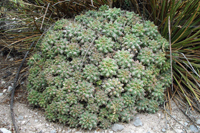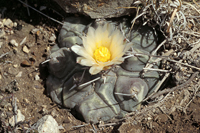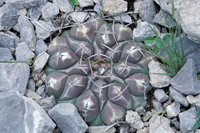Holotype: 14 February 1985, J.J. Halda (PR JJH8502133)
Synonym: Thelocactus rinconensis ssp. multicephalus (Halda & Panarotto) Luethy, Kakt. and Sukk. 50: 80 (1999).
Description
Stem single or clustering, depressed or globose, 6-15 cm tall, 8-20 cm wide. Ribs indistinct. Tubercles conical. Areoles without glands. Central spines 4-5, 10-120 mm long, ochre to greyish, straight, acicular. Radial spines absent. Flowers 30-60 mm wide, white to light pink. Seeds 2.1 x 1.6 mm, testa cells tabular with a verrucose surface sculpture.
Distribution
Mexico, Nuevo León and San Luis Potosí, occurring in matorral xerofilo on limestone hills, at elevations of about 1600 to 1700 metres above sea level. Its range lies within the Meseta Central subregion of the Chihuahuan Desert ecoregion.
Comments
It is one of the last taxa that have been described, even though this entity has been known in Europe for some time. At the type locality it is often clustering, forming small clusters, and thus the name. It is found however also in several locations more to the south, down to Matehuala in San Luis Potosí. In these localities it has single, depressed stems. It is a beautiful species, with depressed or globose stem, sometimes clustering, of a blue-green marbled colour, completely divided into tubercles. The spines are not differentiated into centrals and radials, and they are variable in length. The flowers are generally white, rarely pinkish. This species may easily be confused with Thelocactus rinconensis, especially the form with depressed stem known as phymatothelos, from which it can be distinguished by the different stem colour, the absence of ribs and the different anatomy of the epidermis. Indeed, multicephalus has only one hypodermal layer, while all the taxa belonging to the rinconensis complex have a multi-layered hypodermis.
Thelocactus multicephalus Halda & Panarotto, Acta Mus. Richnov. Sect. natur. 5: 40 (1998).
 Thelocactus multicephalus
Thelocactus multicephalus
Photo: G. Hinton
enlarge
 Thelocactus multicephalus
Thelocactus multicephalus
El Desierto, Nuevo León
Photo: A. Mosco
enlarge
 Thelocactus multicephalus
Thelocactus multicephalus
Maravillas, San Luis Potosí
Photo: A. Mosco
enlarge